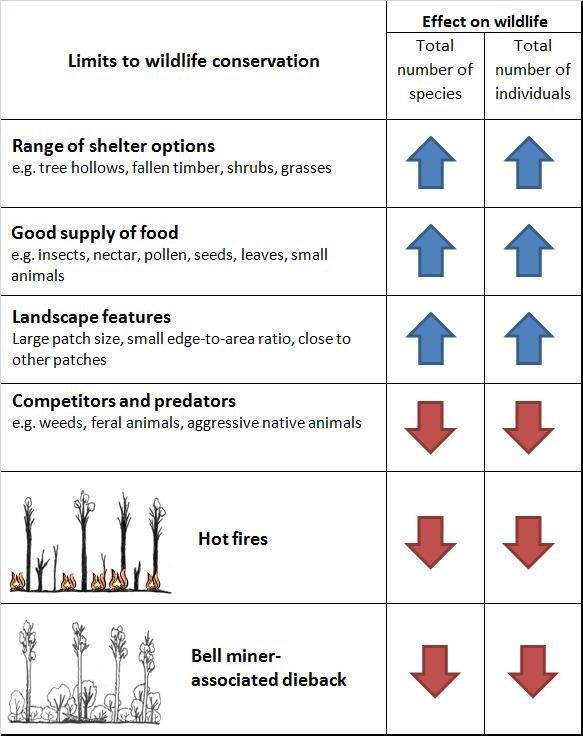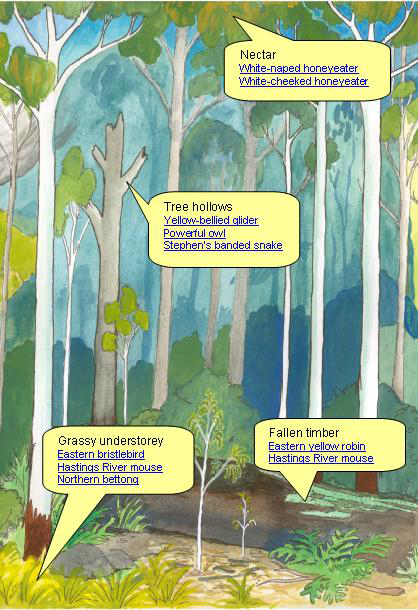Wildlife
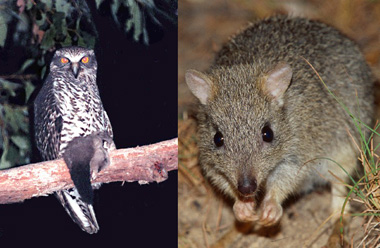
Potential to conserve wildlife
Wet sclerophyll forest in Queensland supports many different types of native plants and animals—including at least 25 threatened or priority species—so restoring wet sclerophyll forest has great potential for conserving wildlife.
Some threatened native species that occur in wet sclerophyll forest include the:
- powerful owl (Ninox strenua)
- northern bettong (Bettongia tropica)
- yellow-bellied glider (northern subspecies; Petaurus australis unnamed subspecies)
- eastern bristlebird (Dasyornis brachypterus),
- Hastings River mouse (Pseudomys oralis)
- plants Boronia keysii and Daviesia discolour.

Limits to wildlife conservation
Most actions that will accumulate carbon in wet sclerophyll forest (such as not clearing trees, preventing hot fires, and controlling dieback) will also benefit wildlife by reducing threats.
Different types of shelter for wildlife, a good (and varied) supply of food, the removal or control of weeds and feral animals, and the size and shape of habitat patches and their distance from each other, will help conserve wildlife in wet scherophyll forest.
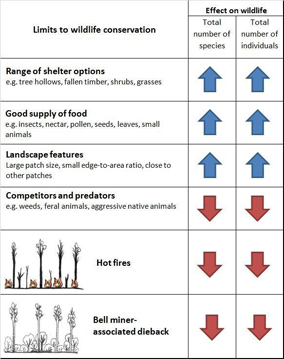
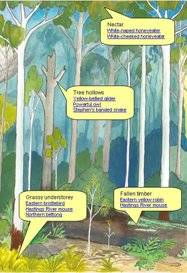
Habitat for wildlife
Understorey structure—shrubby or grassy?
Wet sclerophyll forest can have an understorey that is mostly shrubby (often including rainforest plants) or mostly grassy. The type of understorey has important implications for wildlife conservation, as some species prefer dense understorey shrubs, while others depend upon a more open, grassy ground layer.
Wet sclerophyll forest with a grassy understorey is an important habitat for at least three threatened species—the northern bettong (Bettongia tropica), eastern bristlebird (Dasyornis brachypterus) and Hastings River mouse (Pseudomys oralis). The wet sclerophyll habitat becomes unsuitable for these species when grasses are replaced by rainforest shrubs. Actions to maintain a grassy understorey (e.g. by burning, see ‘fire’ under Threats to wildlife below) are recommended for the conservation of these species. However, wet sclerophyll forest with an understorey of rainforest shrubs will provide habitat for many other species that prefer this type of vegetation.
Best understorey structure type
As the landholder, if you have a choice, and want to conserve wildlife, which is the best type of understorey to maintain? The first step is to find out whether the threatened species that prefer a grassy understorey (listed above) have been recorded on your site, or are likely to colonise your site if suitable habitat is present. (To find out, contact your local Department of Natural Resources, Mines and Energy office, Queensland Parks and Wildlife Services regional offices or the wildlife branch of the Department of Environment, Science and Innovation.)
This is because all 3 species have very restricted distributions and specific habitat requirements, and may not need to be considered if they are unlikely to ever occur on your site. However, if your site may provide habitat for either the northern bettong, eastern bristlebird or Hastings River mouse, then restoring and/or managing a grassy understorey should be a high priority for conserving wildlife at your site.
Shelter and food
| Feature | Benefits for wildlife | Used by |
|---|---|---|
| Trees and shrubs |
Nesting, shelter and feeding sites
A diversity of tree and shrub species that flower and fruit at different times can provide a continuous food supply (nectar, pollen, fruit and insects) for animals Shrubs provide important nesting and foraging sites for small birds, and different species of shrubs support different insects Some animal species need trees and shrubs of a certain size or age (e.g. saplings or dead, standing trees) | Birds, invertebrates, mammals, reptiles, frogs, parasitic plants (e.g. mistletoe) |
| Tree hollows | Shelter, nesting, a place to find food | Parrots, treecreepers, bats, gliders, snakes |
| Fallen timber | Shelter, basking and feeding areas | Birds, reptiles, frogs, mammals, invertebrates |
| Leaf litter | Shelter and feeding areas | Birds, invertebrates, reptiles, frogs, mammals |
| Rocks | Shelter, basking and feedings areas | Invertebrates, reptiles, frogs, mammals, plants |
| Mistletoe |
Nectar, berries and nesting sites
Can provide nectar and berries at times when these foods are scarce in the landscape | Birds, invertebrates, mammals |
| Invertebrates | Food, pollination, seed dispersal | Birds, reptiles, frogs, mammals, plants |
| Fungi | Food, beneficial relationship with plants | Mammals, invertebrates |
Landscape features
| Feature | Benefits for wildlife |
|---|---|
| Large patch size |
Support larger populations of plants and animals
Support animals that need large territories and/or occur in low population densities May also support more species of wildlife |
| Small edge-to-area ratio |
Patches that are rounded in shape suffer fewer ‘edge effects’ than patches of a similar size that are long and thin
Edge effects include increased weed invasion, predation, wind, sun and temperature, and all of these can have important impacts on wildlife |
| Close to other patches |
Allows animals and plants to disperse between patches
Reduces the risk of predation for animals when they move between patches Improves the exchange of pollen between patches |
| How much of the landscape is cleared |
Birds and mammals are negatively affected if more than 70% of the landscape is cleared of suitable habitat
There is also an interaction between grazing and how much of the landscape is cleared, as cattle tend to congregate in the remaining patches of woody vegetation If most of a landscape, or vegetation type, has been cleared, this also means that any remnants are very important for wildlife conservation, even if they are small or in poor condition. These remnants may provide valuable source populations for restoring other parts of the landscape |
Habitat features used by some species that live in wet sclerophyll forest
| Tree hollows, cracks & crevices | Fallen timber | Trees & shrubs | Grasses | Nectar/sap | Fungi | Insects | |
|---|---|---|---|---|---|---|---|
| Mammals | |||||||
| Yellow-bellied glider Petaurus australis | x | x | x | ||||
| Northern bettong Bettongia tropica | x | x | |||||
| Hsatings River mouse Pseudomys oralis | x | x | x | x | |||
| Birds | |||||||
| Eastern yellow robin Eopsaltria australis | x | x | x | ||||
| Powerful oil Ninox strenua | x | x | |||||
| White-naped honeyeater Melithreptus lunatus | x | x | x | ||||
| Eastern bristlebird Dasyornis brachypterus | x | x | x | x | |||
| Plants | x | x |
Threats to wildlife
| Threat | Impacts on wildlife | Wildlife affected |
|---|---|---|
| Weeds and feral animals |
Competition, predation
Some management actions to control weeds and feral animals can also have negative impacts on native species | Many different types of plants and animals |
| Bell Miner Associated Dieback | Loss of leaves and branches from canopy trees, and tree death. This has a negative impact on the many animal species that rely on large trees. Bell miners chase away other bird species. Increased densities of understorey shrubs (including lantana) can have a negative impact on native plant species | Many different types of plants and animals |
| Clearing |
Destroys many plant species and also removes the food and housing of animals that depend on trees and shrubs
Animals which have little or no capacity for dispersal are severely impacted | Many different types of plants and animals |
| Grazing pressure | Uncontrolled grazing by feral and native animals can reduce shelter and food for wildlife by slowing and preventing the establishment and growth of trees, grasses and understorey shrubs, and by trampling and reducing the amount of litter and fallen timber | Many different types of plants and animals |
| Fire |
Hot fires may destroy fire-sensitive vegetation; food resources for animals; simplify vegetation structure; and burn relatively large areas which can disadvantage animals that rely on patchy habitats, or a combination of burnt and unburnt habitats
Even low severity fires can remove habitat such as large hollow-bearing trees that provide essential resources for many animals Wet sclerophyll forest becomes unsuitable for 3 threatened species (the eastern bristlebird Dasyornis brachypterus, northern bettong Bettongia tropica, and Hastings River mouse Pseudomys oralis) when grasses are replaced by rainforest shrubs. Certain fire regimes are recommended to maintain a grassy understorey in the known or potential habitat of these species | Many different types of plants and animals |
